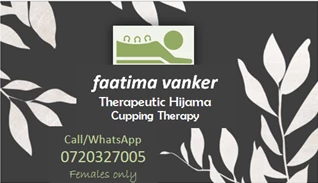Bodyworks - Pineside (3610)
New Germany, eThekweni / Durban, KwaZulu-Natal
Best match results for bodyworks in Pineside + 5km.
Dr Leshmee Ramdiyal is a registered homeopathic practitioner that utilises a holistic approach and individualised therapy to address the root cause of illnesses. The aim of her treatments are to restore the body's natural balance, ability to heal and prevent further complications allowing patients to lead a happier, healthier life. She combines homeopathy, nutraceuticals, phytotherapy, biopuncture and Bach remedies to safely treat a variety of conditions and reduce the side effects of other medication.... Read more
Other related businesses in and around Pineside (within 20km)
What is Cupping Therapy/Hijama? Cupping is the process of applying cups to various points on the body by removing the air inside the cups to form a vacuum. Wet cupping (hijama) is the process of using this vacuum at different points on the body with incisions in order to remove 'harmful' blood which lies just beneath the surface of the skin. Benefits of Hijama • Detoxification of stagnant & acidic blood • Improves circulation • Balances hormones • Enhances general well being •... Read more



